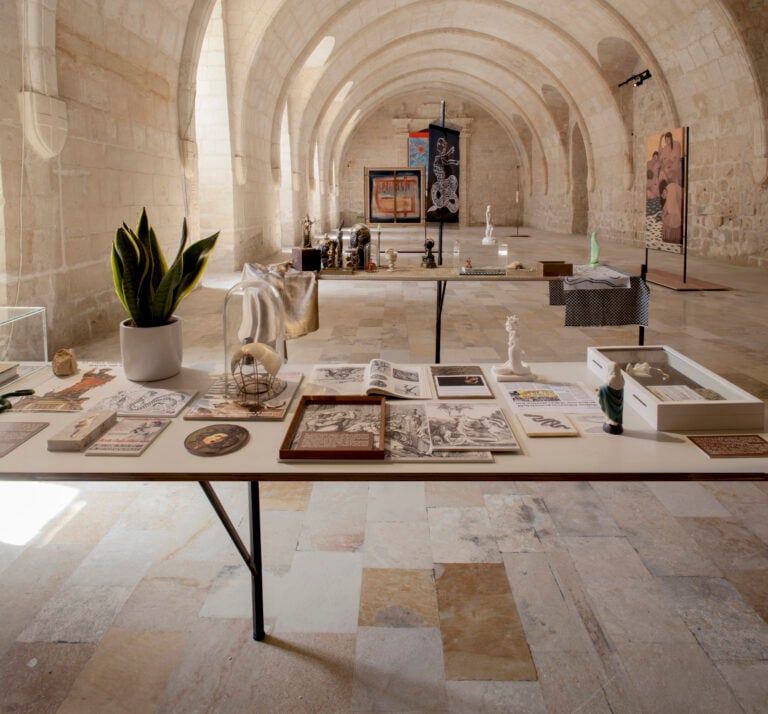On March 13th the Malta Biennale opened its doors, an event dedicated to contemporary art that can be visited until May 31st curated by Sofia Baldi Pighi. The project is ambitious: it is spread across multiple exhibition locations including the island of Malta with the locations of Valletta and Cottonera, inviting you to also go to Gozo, a small island that can be reached in just under an hour. The biennial aims, at a curatorial level, to address some reflections on the predominant and neglected narratives of the cultural landscape Mediterraneaninherited from past generations and which are well suited to this island, in the center of the western Mediterranean, halfway between Italy and North Africa.
At the end of April I had the opportunity to visit it and I would like to share the experience and enjoyment of the event, in its first edition. The most attentive will have already read some articles presenting the biennial. But I believe that the added value of physically going on the one hand can be stimulating for planning a visit and, on the other, offers the opportunity to immerse oneself in the concreteness of locations and works and evaluate the experience of use as a wholeconsidering the ease of accessibility and communication of information, as well as the ability to understand the themes and stimuli of such a complex project.
The first Malta Biennial and its locations
I write these words as a critic and curator. Unfortunately, in cultural events that bring together multiple exhibitions or multiple exhibition venues, there is a risk of falling into a certain sectoral self-referentiality, whose tendency is that of underestimate a series of benefits designed to make the visit a pleasant experience, simple despite its complexity, and capable of conveying the concepts addressed to the greatest number of people. The perception of visitors should not be underestimated who, if happy and satisfied with what they have seen – and understood – will tend to repeat the experience, thus playing in favor not of the single event, but of the entire visual arts system. The strong point of this Maltese Biennial are certainly the location who host the event. With the access ticket it is possible to enter sumptuous palaces and see the (numerous) collections inside them, visit the ancient citadels, the very baroque church of Tal-Pilar, the Main Guard Palace and Fort St. Elmo with its National War Museum, home to one of the main sections of the event. Tickets are sold for a single location or for some combinations indicated on the website, which requires time to be taken to understand the many offers available.
The article continues below
The difficulties of the experience of visiting the Malta Biennale
Focusing attention on the visit experience, the difficulties encountered encompass a series of shortcomings which, in sum, create difficulties in understanding the coherence and quality of the curatorial choices, to the point of involving some more concrete problems. It starts from lack of a map provided at the ticket office. A lack that becomes a tragedy if you think about the difficulty of moving around different islands, each with multiple exhibition locations. Don’t specify that Cottonera is a citadel overlooking the other side of the gulf of Valletta, it’s not trivial for those who go there for the first time and are forced to understand it from Wikipedia! A greater difficulty if the proper name of the city is declined in its sense of Greek or Arabic derivation: Cospicua or Bormla. Not only that, the map allows you to move quickly, mark the routes according to opening hours and your availability, as well as understand where the pavilions of the hosted nations are located. Another obstacle is found in the lack of coordinated image signage: if in the external totems the colors have a bright and visible gradation that goes from purple to red, this tragically gives way within the exhibition itinerary to an iron structure on which a minimal black writing stands out, often making research necessary of a contact person who can provide information. The same structures, but in larger dimensions, can be found placed on the walls in the locations, with room texts dedicated to the artists. These are poorly positioned and illuminated, making reading equally difficult. In one case the PVC with the lyrics had detached from the structure, in another the wind had torn away the material.
The case of the Mediterranean Matriarchives
In collaboration with Heritage Malta, the University of Naples L’Orientale, the Center for Postcolonial Gender Studies and the scholars of the MatriArchives of the Mediterranean, the first thematic section of maltabiennale.art is born which explores the question of the archive in context of creativity, memory and the female artistic and performative community of the Mediterranean region.
The construction of a great coherent heritage that over time it spreads to protect, enhance and propose the immense scope of female visual art is necessary and invigorating. The Mediterranean, a truly unique starting point given the great historical value that this small sea has taken on since the development of the first civilization and the strong links with the veneration of the first Goddesses Mothers, when the human being was still sedentary and the great magic of the feminine and of conception was venerated. The limit of the project is broken by the lack of ability to coherently and forcefully create an understandable direction. A missed opportunity, that of accompanying us in the experience of generating a “feminine memory” that can grow and tell its story over time. On display – in the spaces of the Grand Master’s Palace in Valletta dedicated to the project Matriarchives of the Mediterranean – authors of different generations talk to each other, but without there being an evident and understandable curatorial line.
1 / 13
 2 / 13
2 / 13
 3 / 13
3 / 13
 4 / 13
4 / 13
 5 / 13
5 / 13
 6 / 13
6 / 13
 7 / 13
7 / 13
 8 / 13
8 / 13
 9 / 13
9 / 13
 10 / 13
10 / 13
 11 / 13
11 / 13
 12 / 13
12 / 13
 13 / 13
13 / 13
An incomplete Mediterranean
I say this with regret, because the works of authors such as the American of Italian-Cuban origin Amy Bravo, the German Bettina Hutschek or the Chilean Cecilia Vicuña, do not outline a cohesive path within the theme. Although some of these authors were invited with projects commissioned by the Biennale itself, from the works and texts in the room there is no link that can be identified as a “starting point” consistent with the centrality of the Mediterranean, the title of the exhibition. Furthermore, the invitation was extended to authors whose origins are far from the Mare Nostrumtotally ignoring the presence of living female artists “on the opposite side”. Maghreb, Tunisia, Egypt… Countries that certainly overlook the Mediterranean Sea more than England, whose female gaze has been totally excluded and not considered. An absence that is even more “noisy” in this delicate historical moment. A choice far from the concept of sisterhood, but also just the network that art offers. Welcoming the entire Mediterranean basin would have created a constructive and peaceful opposition towards those who still believe in borders and those who see the act of violence as a solution, without reflecting on the fact that hatred can only generate more hatred.
A missed opportunity that I hope can also be food for thought for the organizers but, above all, for the future of MatriArchives. I repeat, a necessary idea, but perhaps to be taken up with greater coherence, also for the Malta Biennial itself.
Alessia Locatelli
Artribune is also on Whatsapp. Simply click here to subscribe to the channel and always be updated
















